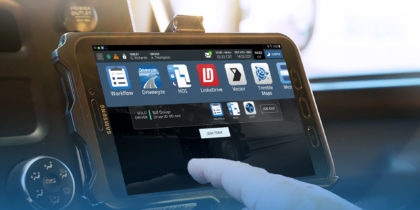There has been a paradigm shift in the enterprise. Where business strategies once drove companies to explore new technology, we’re now seeing technology fuel business strategies. Investment in business technology has experienced 62 percent growth in total technology purchases made between 2010 and this year. Now, new technology inspires strategy and operations giving enterprises a competitive advantage, new efficiencies and revenue opportunities.
For an enterprise to succeed in today’s economy, it must evolve to a point where technology propels the business, while also simplifying the experience for the user and for employees. It must be nimble in adjusting its approach to technology to keep up with industry growth and market trends. This begins with listening to customers, industry partners and employees to understand how to increase productivity, provide a delightful user experience and to spark collaboration.
This year’s Consumer Electronics Show (CES) highlighted four trends and opportunities generating buzz in 2016 — the Internet of Things (IoT), secure workforce mobility, digital signage and virtual reality. All of these have moved well past the incubation stage and are making a real impact for businesses, driving innovation and simplification. I believe that every organization has a responsibility to evaluate these trends to understand how they can be a catalyst to give their business a competitive advantage.
The Internet of Things Explodes
The enterprise of the future will be driven by connectivity between devices. This year, Gartner predicts that spending on new IoT hardware will exceed $2.5 million each minute. Businesses are harnessing the opportunity to use connected technology at an accelerated pace so that they can empower employees on the go and foster better customer experiences.
In fact, 65 percent of IT decision makers reported the IoT as a top priority for keeping their businesses globally competitive. Providing employee and customer connectivity to the IoT isn’t optional. It’s a must. With 80 billion devices expected to be connected by 2020, your enterprise needs to be situated to support the next hybrid ecosystem of connected devices. The IoT aims to make everyone more efficient by leveraging data, improving decision-making and taking advantage of opportunities as soon as they arise.
In the transportation business, for example, PeopleNet, a leading provider of fleet telematics technology, has enabled improved electronic logging by encouraging its trucking customers to move paper-based processes into electronic formats via IoT-enabled technology. This transition saves drivers and fleet managers time and makes it easier to comply with regulations and reporting.
For an enterprise to get started in leveraging the IoT, they must evaluate all of the touch points in place with employees and customers. Evaluating these areas will help determine how the IoT can improve everyone’s experience.
Secure Workforce Mobility Accelerates
Mobile has changed the way we do business by enabling greater employee productivity, accelerating workflows and enhancing customer service. It has also unleashed the ability to work anywhere, anytime, with an intuitive user experience — with demands increasingly driven by millennials.
However, as enterprises shift to a mobile-first mindset, they are forced to balance the need to provide easy mobile access to corporate data with the potential security risks that this entails. Security risks can come from lost or stolen devices, or people leaving the company with unsecured assets. Any sensitive company information stored on a device can put the organization at risk of a data breach that can be costly to the brand.
Securing mobile devices is essential, not only for employees and customers, but for the enterprise. However, the security solutions must also be user-friendly, especially in the age of BYOD where employees use mobile devices for both work and personal use. If imposing security solutions makes using mobile devices complex, employees won’t continue using them to their full potential.
We’ve seen mobile security success in the healthcare sector as they transition patient data from paper to electronic record management. Saint Elizabeth, a Canadian health care provider, implemented an on-device mobile security solution for remote teams. They provided 5,000 remote healthcare workers with mobile solutions that could not only support health and productivity applications, but also protect patient information. Saint Elizabeth is now expanding the rollout nationally after experiencing success from the pilot program.
For implementation, remember that the mobile security solutions your enterprise deploys must be smart, connected, and secure. Your employees should not feel limited while working remotely or traveling; rather they should be completely supported by an interconnected and seamless mobile solution.
The Future of Digital Displays is Bright
Conveying an impactful message to customers involves more than putting a large, static display in a window. In a recent Forrester survey, enterprise business and technology decision-makers revealed that they are investing in digital customer journeys — with 39 percent investing in improving cross-channel experiences that extend from mobile to laptop to retail store kiosk. Digital customer journeys not only deliver compelling messages, but should also engage customers and improve their experience.
The future of a digital customer experience is delivering dynamic and personalized content to support customer interactions on every screen, from wearables to video walls. Smart digital signage displays come with embedded systems-on-chip media players and built-in Wi-Fi, making it simple to deploy. Early adoption offers a competitive advantage supporting new customer acquisition, while delivering engaging experiences.
A great example is Maverik, a regional convenience store and gas station chain. Maverik wanted to showcase high-energy videos and digital content to build its brand identity. To do this, the chain deployed a digital signage program that included digital menu boards and promotional displays on its soda dispensers, along with high brightness displays in its window facing gas pumps to capture customer attention.
A good place for your enterprise to start is to examine your own customer’s journey to determine how to best integrate digital displays. From mirror or transparent OLED displays to the ultra-slim video walls showcased at CES, the customer experience becomes something richer and more engaging — something that cannot be matched through online experiences.
Virtual Reality Adoption Ignites
Virtual reality (VR) adoption is here and now, and we have seen VR move from consumer and gaming uses to become a business advantage when properly deployed. The market is set to grow at a fast rate with the number of active VR users expected to reach 171 million by 2018. Yet, many wonder how to incorporate VR tools into existing business models, and what value VR brings to the table. The power of virtual reality comes from the context of its content. Drawing from real life, virtual reality designers can leverage that connected sense people have with ideas, images and experiences to create compelling content in immersive 360-degree environments.
Automaker Audi is one brand that has differentiated itself from competitors by integrating VR technology into the auto dealership experience. By embracing VR and other digital technologies, the automaker transformed its London Audi City location into a virtual showroom using digital solutions to enable customers to navigate the shopping experience on their own terms.
In the health care sector, one VR training application allows viewers to observe the mind of a person with schizophrenia. The simulation has participants on a city bus surrounded with the sights and sounds seen and heard by a person with the illness. Medical practitioners can use VR to not only create new training procedures, but simulate catastrophic scenarios, examine rare conditions and witness complex procedures through the eyes of skilled practitioners.
Implementing innovation-enabling technology drives customer engagement and gives your company the competitive edge it needs to make life simpler for your teams and customers. When proposing new technology into existing business models, short- and long-term ROI is priority. As you consider investing in technology, determine how each innovation will benefit your overall enterprise business. Listen to your company’s key decision makers — whether that’s board members, partners or customers — while garnering support from IT to identify the best investment. Whether your business implements these innovations, or others, take advantage of exploring the right technologies that meet the specific needs of your enterprise.







